FiiO needs no introduction to our lineup. For over a decade now, they’ve been one of the most visible and well-known brands in headphone audio. Their products are priced effectively and target what the majority of audiophiles are looking for with an aggressive product line. What started with some measly amps and line-out-docks for the iPod has now expanded into an empire of DAPs, dedicated AMP/DAC units and headphones. I’ve been reviewing FiiO’s hit products for over half a decade now and have always been delighted with the level of quality they are able to achieve given their price point.

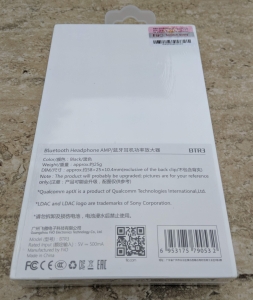
Today, we at Guru have FiiO’s latest product, the FiiO BTR3 Portable High-Fidelity Bluetooth Amplifier. This is FiiO’s second Bluetooth amplifier with the first being the BTR1. Years ago, it was unconventional for audiophile targeted companies to even produce something wireless. However, with advances in wireless technology (Bluetooth specifically), the products have advanced to the point where adoption amongst even the most ardent headphone-philes is happening.
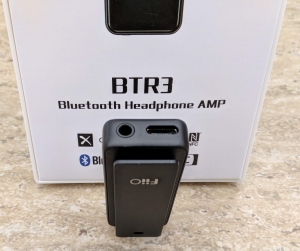
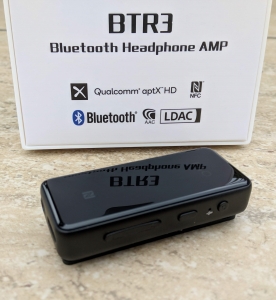
It’s simple really, the users with the stack of bricks rubber banded together on Head-Fi are the few. The majority of headphone audiophiles like to still have creature comforts like smartphones and prefer that as the only device they carry. DAPs are a thing but the ‘good’ ones everyone eyes are expensive and their phones already exist! Enter the recent phenomena of audiophile Bluetooth receivers like this BTR3 or the ones from our friends at Astell Kern, Bluewave, Earsonics and many more. They recognize that a sizeable market wants the convenience of high-quality portable audio with sources like a smartphone.

Three things have occurred in the realm of Bluetooth specifically at the right time to support this. The first was the mass adoption of streaming standards and codecs from Qualcomm and Sony. These are in the form of Qualcomm AptX/AptX HD and Sony’s LDAC. While these aren’t new, they have only since mid-2017 been hitting the mass market hard. The second is the release and wide smartphone adoption of the Bluetooth 5.0 standard; the most pertinent thing for audiophiles here is the increased bitrate transmission to 2Mb/s. Lastly, is smartphones in 2018 running the latest iOS and Android supporting all of these together right out of the box. Thanks to a strategic move from Sony, all versions of Android starting with 8.0 Oreo will come with the LDAC codec built into the source code; the pesky licensing is all dealt with here. Qualcomm’s AptX is another story but most devices are coming with support for that as well through paying a licensing fee.
All these factors combined create a fusion of the right time for high-quality wireless audio to hit personal headphones. Headphone jacks disappearing off smartphones is also a key point here and has helped further the ‘need’ for a Bluetooth amplifier for your portable headphones.
Build:
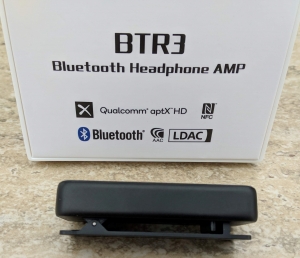
The contents of the box contain just the necessities. Inside is the BTR3 device itself, a USB-C charging/data cable, lanyard, and the extraneous papers. It’s straight to the point just like the outer packaging is. All the marketing jazz is found on its website, you’ve already bought the device to see the inside so why continue to sell you on it.
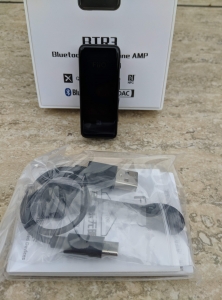
The first thing that stood out to me about the device was its exterior housing. It’s nearly all metal save the screen and inspires confidence with how it feels in my hand. There are no squishy elements anywhere and tolerances on the rear clip are tight. FiiO has come a long way from its early days where 3.5mm aux jacks might protrude a little there or be ever so misaligned here. The BTR3 comes with its two I/O ports, the 3.5mm headphone output and USB port, fitted precisely to the frame.
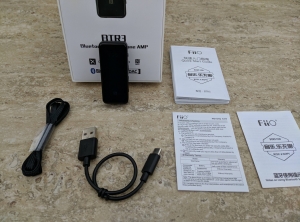
The buttons on the device are small slivers on the side. They match the rest of the look and come with a microphone as well. I personally would have preferred larger buttons and an easier tactile way to differentiate the +/- volume buttons more clearly than from memory. As far as the feel of pushing the buttons down, it’s clicky but not overly so while steering clear from being mushy. It’s middle of the road here.
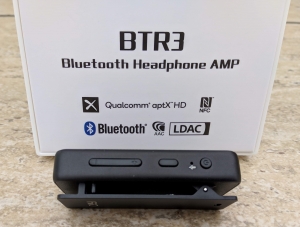
Can I say that it also looks as good in real life as the promo pictures? Often times, the gradient of the metal or shine are all computer processed effects added for the picture. The BTR3 came to me as the pictures make it truly look. The metal is matte with a metallic shine to it. The front panel does indeed have that nice separating curved edge and glossy finish. What the promotional pictures don’t show is the grainy texture of the real unit but that’s to be expected.
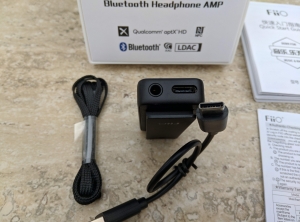
The BTR3 is a study device that ushers in a new era of FiiO design. Gone are the days of creaky plastic and roughly bent metal bodies. In are the days of leading class craftsmanship and production. The device looks good and is as solid as it looks.
Usability:
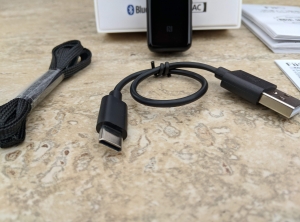
If there is one thing the BTR3 crushes, it is its usability. Out of the plethora of Bluetooth devices, I have used over the years and my other Bluetooth receivers, the BTR3 has the most seamless experience thus far. The device automatically enters pairing mode when it is powered on the first time and gets connected within a moments notice. But this is quite normal. What isn’t is how fast and reliable it is in finding your BT source continuously every single time on bootup and after.
Other devices have a noticeable lag and sluggish wait when it comes to connecting. Not the BTR3! It has always been able to find and connect to my source within two seconds of powering on throughout my month of using it. Tests where I intentionally walk my source away for a prolonged period of time (10+ minutes) and bring it back had the BTR3 reconnected within as short as ten seconds of being back in range again. Phenomenal! For those that don’t use Bluetooth devices often, the scenario I described above is actually one of the largest annoyances of the standard and its ‘un-seamlessness’ and why Apple made its own W1 standard.
I have never had a better Bluetooth connectivity experience than with the FiiO BTR3. While it’s not to the level of Apple’s W1, its performance at being able to connect to a source and its speed at doing so is immaculate. It’s long held that Chinese Bluetooth devices are often the slowest and most unreliable at connecting to. FiiO has proven that wrong and has trounced many devices, even domestic here in the United States with how well the experience is. FiiO deserves a round of applause here for this feat.
If there is one area that FiiO could work on, it would be the audible Bluetooth interface. I’m talking about the subtle audio queues the device provides you to let you know what state it is in (ON, Pairing, Turning OFF). The best I’ve seen is the Bluewave GET which has put a lot of design language into how they structure the tones. FiiO, on the other hand, is still rough in this aspect. The beepy tones and light flashing on the front facing logo are not intuitive as to what the device is doing. The slightly confusing and large user manual does not help in this either.
One example of this confusion is when the device is turned off. FiiO has programmed it so that after the de-escalating tones (done very right), the device then emits two higher pitched sounds. This is paired with the logo flashing on and off a few times. The first few times this happened, I was afraid I accidentally put the device into pairing mode or reset it. Not the end of the world and something I got used to by the end of the week. It turns out that it is not possible to put the device into pairing mode by continuously holding the power button anyway (how many devices start the pairing process). In the future, I’d recommend FiiO to invest more into intuitive and subtle interface design in both the physical space and notification tone areas. These small things play a huge part in how the user perceives the device and can quickly pick them up and get started with.
The last itch I have with the BTR3 is the DAC switching. The function of switching the device from Bluetooth mode into a USB DAC is not mentioned in the user manual and quite hidden. I believe that this may be due to the fact that I have an early product release and that new manuals may include it. Triple tap the multifunctional button and the device switches between its wireless and USB DAC operation. Not the most intuitive again but it works. Do note using the BTR3 as a USB DAC limits you to 44.1KHz/16Bit.
The faults mentioned are honestly minor in the end. They are small scratches on an otherwise great experience. The FiiO BTR3’s wireless connectivity, usability, and ease of use are unparalleled on the market and should be a baseline of functionality for other audiophile manufacturers moving forward.
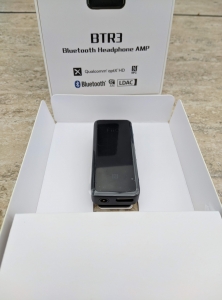
Sound:
The BTR3 was utilized with the following devices with the associated streaming codecs for sound testing:
- Essential PH-1 (Android 8.1 Oreo) | Sony LDAC & AptX HD
- Dell XPS 15 9550 | AptX, SBC, and USB DAC
- Custom Desktop with ASUS BT-400 | SBC
I found the general sound signature of the FiiO BTR3 to be dark and bassy. It’s a fun sound that caters towards music that requires more kick and oomph to it. It’s the opposite of revealing and tends to hide artifacts and defects fairly well at the loss of detail and complexity as well.
Listening to the MTV 1994 Live recording of “Hotel California” by the Eagles, I found the ever-present bass kick to be the highlight. The percussion is more forward and makes its heavy presence known. It’s more punchy compared to my baseline tests but also has some looseness around the edges. Soundstage is adequate but can be considered to be on the lower range. The Live production still felt semi-realistic but did not have the encompassing feel I was expecting. The vocals and string instruments were well balanced. Lively, warm and with a buttery smooth consistency. Don Henley’s delivery was pulled back in the mids and natural sounding, but again the detail was missing. I found the same characteristics apply to instrumentals as well. The plucks of the strings, shakes of the percussion instruments had enough girth and weight to keep the mids grounded but almost always lacked in the sharp bite.
Next up was “Gangsta’s Paradise” by Coolio. The song features a thicker and bassier beat which the BTR3 compliments. The extra kick of the bassy BTR3 helps put the song into overdrive. My other equipment was too clean here and often lacked that thump I was looking for. Part of the experience of this hobby is to enjoy the music rather than critiquing the gear and this song begs for an added couple dBs of bass boost. It’s less purist but FiiO has never been about keeping to the clean cold tonality that seems more ‘audiophile’.
Finally, I put on “Wherever You Are” by One OK Rock. This song is clean and somber with a reminiscent feel before it pushes into a harder rock mood. The BTR3 performed well at keeping the neat tone at the beginning and didn’t intrude into the space with its darker tendency. The FiiO is thick, yes, but it knows where to stop and not intrude into the pristine spaces that don’t want it. The messier later parts of the song which feature more dynamic range compression have the BTR3 quickly hiding the flaws. Often, this section would get bright or too hot for my ears due to the compression. The BTR3’s buttery smoothening filter works wonders here and aids in countering the compression to an extent. It doesn’t reverse the compression no, but it does help in providing a band-aid.
The FiiO BTR3 has the FiiO house sound on steroids. Dark, bassy, with slightly pulled back mids and an overly fun spin. This time it’s turned up to 11 and not always for the better. Detail is largely pulled back and sharpness is down across the board. And I’m not even mad. This is my go to “audiophile targeted” Bluetooth receiver.
The reason is simple, it’s a portable wireless receiver I use on the go. The BTR3 is my choice when I’m taking my dog on walks, need a quick setup when I switch to my laptop or need to add Bluetooth to an older car that only has an AUX jack. The smooth and detail adverse sound is a plus for me in these situations. I’m the type that would rather things be glossed over and hidden than get bright and hot for my ears. I’m not always in the purist mood and trying to critically listen to my music, especially not when I’m bringing a Bluetooth device around. There are wired Android/iPhone USB DAC/Amplifiers for that and dedicated DAPs. I’m the casual consumer with a hobby for audiophilia 90% of the time I’m on the go. In that situation, I want the smallest amount of devices and recently my smartphone, the Essential PH-1, and the BTR3 have been my daily carried pair.
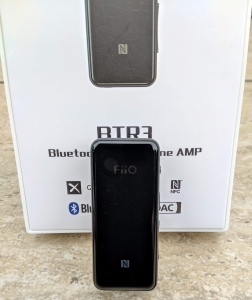
The BTR3 is a $69 device that is loaded with every Bluetooth codec under the sun so it can guarantee the highest level of transmission quality possible. It packs an AK4376A DAC and Qualcomm CR8675 Bluetooth receiver to accomplish this feat. The sound is definitely not the best you’ll get from a dedicated amplifier or DAC at below $100 but its the packaging of all these components together that you do get. And let’s not forget how it’s simply the easiest Bluetooth product from a usability standpoint I have ever used. The FiiO BTR3 gets my recommendation as my go-to Bluetooth receiver and I implore those that need this level of functionality to check out the device.















Want to join discussion?
Feel free to contribute!